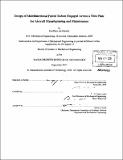| dc.contributor.advisor | H. Harry Asada. | en_US |
| dc.contributor.author | Karasic, Geoffrey Ian | en_US |
| dc.contributor.other | Massachusetts Institute of Technology. Dept. of Mechanical Engineering. | en_US |
| dc.date.accessioned | 2012-01-30T17:05:10Z | |
| dc.date.available | 2012-01-30T17:05:10Z | |
| dc.date.copyright | 2011 | en_US |
| dc.date.issued | 2011 | en_US |
| dc.identifier.uri | http://hdl.handle.net/1721.1/68946 | |
| dc.description | Thesis (S.M.)--Massachusetts Institute of Technology, Dept. of Mechanical Engineering, 2011. | en_US |
| dc.description | Cataloged from PDF version of thesis. | en_US |
| dc.description | Includes bibliographical references (p. 77-78). | en_US |
| dc.description.abstract | The aircraft industry lacks an automated system for wing box manufacturing and maintenance. Currently workers assemble and inspect thousands of fasteners in the wing structure by hand. This manufacturing process consumes valuable time and resources. Mobile robots capable of navigating on the interior and exterior of the wing have the potential to perform the wing structure manufacturing tasks. This thesis describes the design, analysis, and implementation of paired robots engaged across a thin plate. Two robots, each capable of carrying an end effector, are engaged using strong magnets attracting each other and thereby supporting each body against gravity. The robots must move across the surface of the box, while avoiding interference with obstacles fixed to the surface. The multifunctional paired robots navigate the surface with three different operations. The paired robots are automatically loaded and unloaded from the confined box through a small entry hole using the "Flipping" operation. The "Drive and Slide" operation is used on horizontal surfaces. The robots "Step" over obstacles while securely holding each body against gravity. Parametric models of the robots are developed, and the conditions for the successful multifunctional operations are analyzed. The two primary failure modes are tipping of the robots on either side of the thin panel. An optimal trajectory that minimizes the peak tipping moments, while also minimizing how close the robots are to failure is designed to meet the many challenges of the stepping operation. The trajectory ensures that the failure modes are avoided during the disengagement of the strong permanent magnets in the stepping operation. The position trajectories are parameterized using cubic splines with the bounds being the start and end robot configurations. Prototype paired robots are constructed and experimentally tested. The prototype robots performed their multifunctional operation modes on a mock wing structure, validating the design and analysis. | en_US |
| dc.description.statementofresponsibility | by Geoffrey Ian Karasic. | en_US |
| dc.format.extent | 78 p. | en_US |
| dc.language.iso | eng | en_US |
| dc.publisher | Massachusetts Institute of Technology | en_US |
| dc.rights | M.I.T. theses are protected by
copyright. They may be viewed from this source for any purpose, but
reproduction or distribution in any format is prohibited without written
permission. See provided URL for inquiries about permission. | en_US |
| dc.rights.uri | http://dspace.mit.edu/handle/1721.1/7582 | en_US |
| dc.subject | Mechanical Engineering. | en_US |
| dc.title | Design of multifunctional paired robots engaged across a thin plate for aircraft manufacturing and maintenance | en_US |
| dc.type | Thesis | en_US |
| dc.description.degree | S.M. | en_US |
| dc.contributor.department | Massachusetts Institute of Technology. Department of Mechanical Engineering | |
| dc.identifier.oclc | 773819715 | en_US |
